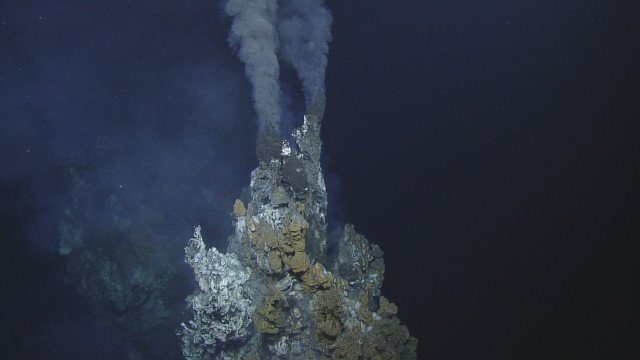Deep-water fish use hydrothermal vents to hatch eggs
Research groups at the Ocean, Darwin Fund and Galapagos National Park Management Board discovered that some larvae hatch their eggs in deep hydrothermal vents, an unprecedented behavior. observed in marine animals.
Using an underwater remote control Hercules Vehicle System (ROV), the team conducted a close-up inspection at depths of up to 4,000m, in a hydrothermal zone operating 45km north of Darwin Island in Galapagos archipelago, discovered in June 2015. There, the experts discovered 157 shellfish, yellow-brown, horned, sized phones.
 Deep-water fish use hydrothermal vents to hatch eggs Picture 1
Deep-water fish use hydrothermal vents to hatch eggs Picture 1
58% of the eggs found were within 20m of chimney-like structures, the hottest hydrothermal vents, and 89% of the eggs were placed in areas with hotter than average water.
The team used the ROV system to collect four eggs and then conducted DNA analysis to show that it was the eggs of the stingray Bathyraja spinosissima.
This fish can use heat emitted from hydrothermal vents to speed up the incubation process. This is not surprising given that many deepwater fish have very long incubation periods, which usually last for several years.
Although this is a new finding for marine animals, similar behaviors have been noted in land animals, such as the Polynesian bird, a Tongan bird nesting in heated soil, and dinosaur fossils in the Cretaceous period.
See more:
- The "dead zone" on the ocean threatens the life and ecosystem of many seas
- The noise of ships affects the communication ability of marine creatures
- 530 million year old fossils have eyes like bees, dragonflies today
You should read it
- Fish are encroaching on the sea kelp species
- Decipher the mystery of the extinction that destroyed 96% of marine life
- Fish have nostrils and mouths but are not present
- The 'dead zone' on the ocean threatens the life and ecosystem of many seas
- Strange creatures hide deep in the ocean floor
- Do fish drink water?
- Ocean acidification changes California's shell structure
- 10 photos showing how small people are in the ocean
- After the river flows into the sea, where did the freshwater fish go?
- Marvel at bizarre fish in the ocean
- Found shelter for corals threatened by global warming
- Surprise with the facts about the ocean
May be interested

Nerves play an important role in the extraordinary camouflage ability of ink

Norway's global seed store requires millions of dollars to upgrade because of rising temperatures

Only 13% of the world's tiger reserves meet the global standards

Underwater sound waves can help to alert tsunami earlier

Coral reefs are threatened by ocean acidification, which can disintegrate before 2100

Identify new shark species in the Atlantic Ocean






 How to own eggs 10 km in Pokemon GO?
How to own eggs 10 km in Pokemon GO? AZ word about eggs in Pokemon Go
AZ word about eggs in Pokemon Go Are fish thirsty?
Are fish thirsty? Do fish drink water?
Do fish drink water? How long does a dinosaur egg take to hatch?
How long does a dinosaur egg take to hatch? Why do dead fish face up on their stomachs floating on the water?
Why do dead fish face up on their stomachs floating on the water?